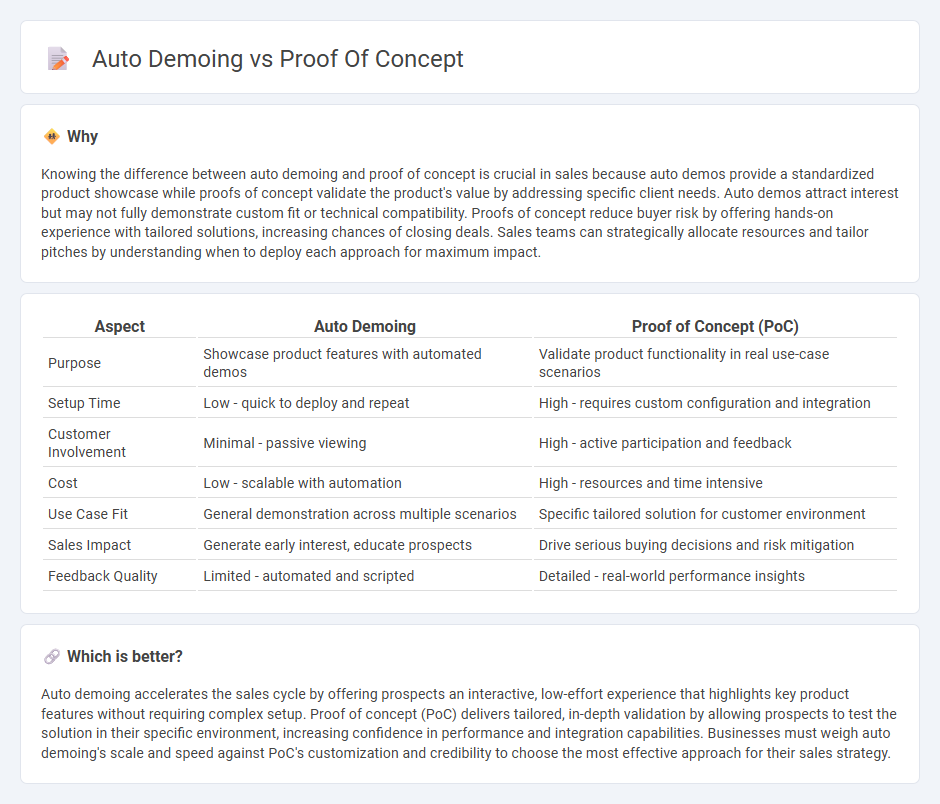
Auto demoing streamlines the sales process by providing prospects with a pre-configured demonstration that highlights key product features and benefits, enabling quicker engagement and decision-making. Proof of concept involves a tailored, hands-on trial where the prospect tests the solution in their specific environment to validate compatibility and effectiveness before committing to purchase. Explore how leveraging auto demos and proofs of concept can accelerate your sales cycle and close deals faster.
Why it is important
Knowing the difference between auto demoing and proof of concept is crucial in sales because auto demos provide a standardized product showcase while proofs of concept validate the product's value by addressing specific client needs. Auto demos attract interest but may not fully demonstrate custom fit or technical compatibility. Proofs of concept reduce buyer risk by offering hands-on experience with tailored solutions, increasing chances of closing deals. Sales teams can strategically allocate resources and tailor pitches by understanding when to deploy each approach for maximum impact.
Comparison Table
| Aspect | Auto Demoing | Proof of Concept (PoC) |
|---|---|---|
| Purpose | Showcase product features with automated demos | Validate product functionality in real use-case scenarios |
| Setup Time | Low - quick to deploy and repeat | High - requires custom configuration and integration |
| Customer Involvement | Minimal - passive viewing | High - active participation and feedback |
| Cost | Low - scalable with automation | High - resources and time intensive |
| Use Case Fit | General demonstration across multiple scenarios | Specific tailored solution for customer environment |
| Sales Impact | Generate early interest, educate prospects | Drive serious buying decisions and risk mitigation |
| Feedback Quality | Limited - automated and scripted | Detailed - real-world performance insights |
Which is better?
Auto demoing accelerates the sales cycle by offering prospects an interactive, low-effort experience that highlights key product features without requiring complex setup. Proof of concept (PoC) delivers tailored, in-depth validation by allowing prospects to test the solution in their specific environment, increasing confidence in performance and integration capabilities. Businesses must weigh auto demoing's scale and speed against PoC's customization and credibility to choose the most effective approach for their sales strategy.
Connection
Auto demoing accelerates the sales cycle by providing potential buyers with interactive product demonstrations that mimic real-world use cases, enhancing understanding and engagement. Proof of concept further validates these demos by allowing prospects to test the solution within their specific environment, confirming functionality and business value. Together, they reduce buyer uncertainty, increase trust, and significantly improve conversion rates.
Key Terms
Validation
Proof of concept (PoC) primarily aims to validate the feasibility and functionality of a new idea or technology through controlled experiments and real-world scenarios, confirming that the concept works as intended before full-scale development. Auto demoing, on the other hand, automates the demonstration process to showcase product features and benefits consistently without requiring manual intervention, enhancing user engagement but focusing less on technical validation. Explore our detailed comparison to understand how these approaches impact project validation and decision-making.
Automation
Proof of concept demonstrates a technology's feasibility by creating a preliminary model, while auto demoing emphasizes automation in showcasing features or workflows without manual intervention. Automation in auto demoing enhances consistency, reduces human error, and accelerates the presentation process by using scripted sequences or AI-driven interactions. Explore how integrating automation can transform your demo strategy for maximum engagement and efficiency.
Customer Engagement
Customer engagement thrives on clear, interactive experiences; proof of concept (PoC) offers tailored solutions addressing specific client needs, building trust through hands-on validation. Auto demoing leverages automation to showcase product features efficiently, appealing to a broader audience with consistent messaging and instant accessibility. Explore how these approaches transform engagement strategies and maximize customer satisfaction.
Source and External Links
Proof of Concept: Definition, Guide, and Examples - A proof of concept (POC) is used to demonstrate the feasibility or viability of an idea by collecting evidence of its practical or business potential, helping teams decide whether to invest in full development; it differs from a prototype and MVP by focusing on proving potential at minimum scale.
Proof of Concept (POC): Definition, Steps and Examples - A proof of concept is a feasibility study conducted early in a project to confirm an idea's credibility and readiness for the market, aimed at solving real-world problems using current technologies and eliminating risks before full development.
Proof of concept - A proof of concept (POC) is a small realization of an idea or method to demonstrate its feasibility, usually incomplete but sufficient to prove that the concept has practical potential, dating back to usage defined in technology development since 1967.
 dowidth.com
dowidth.com